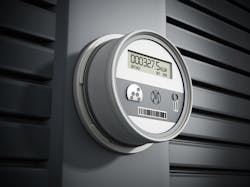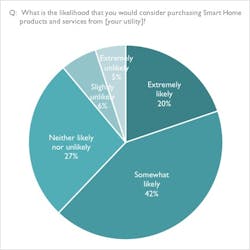Utilities have a unique opportunity to provide new solutions beyond the meter, inside consumer homes. Customer feedback is surprisingly clear about the demand for smart home solutions from their utility. But few utilities recognize the opportunity. They are thus unprepared to deliver against these customer expectations. This short article describes the challenge, opportunity, and next steps which utilities can take to grow their customer relationships in the smart home sector.
If that statement sounds ambitious, it is. While utilities are aggressively promoting the introduction of smart thermostats, supported by energy efficiency programs, most have stopped short of providing more smart home solutions to their customers. Why? These utilities haven’t believed that consumers would expect to buy such solutions from them. And even if consumers were interested in such solutions, that interest would be far below consumer interest in buying them from major retailers (including Amazon, Walmart, Best Buy, Home, Depot, and so forth.)
Having worked with both retailers and utilities, Sprosty Network set out to answer the question. And we have done so by asking customers directly about their interest in buying products and services from their local utility, as opposed to buying such products and services from national retailers.
The results were stunning. In a national survey, 62% of utility customers across the United States stated they’d be likely or extremely likely to purchase smart home products from their local utility. Only 11% were unlikely or extremely unlikely to do so. This looks to be a strong demand signal, to say the least.
But having said that, maybe such consumer interest pales when compared with the consumer interest in purchasing those same products from today’s dominant channels: the major U.S. retailers. With that in mind we set out to ask the question more specifically, while this interest is great, would utility customers really be interested in having their local utility provide such products and versus their current favorite retailer?
The answer? We could say it was a very nuanced feedback. But it wasn’t. Consumers overwhelmingly stated they’d not only consider their utility as a “beyond the meter” smart home solution provider, but in many cases, the utility would be their first or second destination for these solutions! Figure 2 shows this demand, across a range of sub-categories. It compares the local utilities purchase preference with that for the major U.S. retailers.
In the survey, we used the name of the local utility in the relevant geography. Examples of names used include Xcel Energy in Minnesota, Duke Energy in North Carolina, and Pacific Gas and Electric (PG&E) in Northern California. In each of the categories, the utility was one of the top three destinations, and in many cases the utility was THE preferred destination. And while that could be expected in categories such as thermostats and heating/cooling products, it was certainly NOT expected in other categories, such as security, smart appliances, or uninterruptible power supplies.
And, if that wasn’t shocking enough, the difference in purchase intent from the utility, often noted as the number one preferred channel compared with the other retailer scores, isn’t even close. For example, the smart thermostat utility purchase intent is 64%, with the second retailer (Home Depot) scoring 48% and the fifth retailer (Best Buy) scoring 33%. Said bluntly, customer purchase preference for a thermostat from the utility is almost double that of the fifth retailer, Best Buy. But maybe that’s to be expected of thermostats, a category that ties directly to the utilities mission. Maybe this would be very different in other categories? The answer: it’s really not much different. In smart appliances, for example, the gap between the utility preference score of 51% versus the fifth retailer, Amazon, of 27% is again almost a 2X factor. This pattern, with category specific numbers, repeats itself across the survey.
The net impact of this research initiative? It puts the real voice of customers and a pile of qualitative data behind the belief that a utility can, or can’t, be more relevant to its customers. Utility customers are asking their utility to step up and do more for them. This is a clear, resonating demand signal that every utility should hear.
So, now what? Part Two of this article will talk about what specifically the utility customer expects of the utility, versus of the other commercial retail channels. Keeping in mind this huge, clear demand signal, the next article will explore how utilities can show up differently for their customers, in ways that are surprising — and in ways that are different from the existing retail channels. The next part of this article will discuss how utilities can lean into this demand to become increasingly relevant to their customers.
About the Author
Rick Rommel
Rick Rommel is a partner in the Sprosty Network, the founder of the RetailXelerator program, and a distinguished visiting scholar with Stanford University’s MediaX program.


